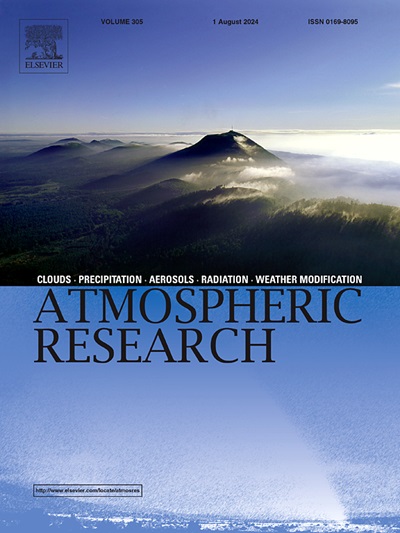Possible relationships between the intra-seasonal variation of winter temperature in Northwest China and Arctic sea ice
IF 4.5
2区 地球科学
Q1 METEOROLOGY & ATMOSPHERIC SCIENCES
引用次数: 0
Abstract
The increasing impacts on regional climate of sea ice anomalies have spatio-temporal uncertainties, this study investigates the possible relationships between Arctic sea ice anomalies and intra-seasonal evolution of winter temperature in Northwest China (with a particular emphasis on Xinjiang). The reanalysis dataset during 1990–2022 from the National Centers for Environmental Prediction and the National Center for Atmospheric Research are utilized, with multiple statistical methods including season-reliant empirical orthogonal function (EOF) and regression analysis being employed. The results show that the first and second EOF modes of intra-seasonal temperature evolution in winter over Xinjiang are characterized by in-phase and out-of-phase variations, explaining 32 % and 19 % variance, respectively. The in-phase (out-of-phase) evolution of intra-seasonal temperature is affected by the in-phase (out-of-phase) variations of sea ice in the Kara Sea-East Siberia Sea-Chukchi Sea (KEsC) and the Barents Sea (BS) during the preceding October. The reduction in the KEsC sea ice triggers upward-propagating wave energy anomalies, which is favorable for the wave train shaping as a meridional dipole pattern from the Ural Mountains to Central Asia in early winter through the stratosphere-troposphere coupling, thereby leading to temperature anomalies in Xinjiang during the following December and January. The BS sea ice anomalies favor the formation and maintenance of a North Atlantic Oscillation-like pattern, the wave energy disperses downstream and enhances in February, triggering a Scandinavian teleconnection pattern-like wave train. This leads to circulation anomalies over Xinjiang, further causes temperature anomalies in February. In summary, the KEsC and BS sea ice in October serves as key precursor signals impacting the intra-seasonal evolution of winter temperature in Xinjiang, with the significant impacts of sea ice in these two key regions on intra-seasonal temperature variations occurring at different times.
求助全文
约1分钟内获得全文
求助全文
来源期刊

Atmospheric Research
地学-气象与大气科学
CiteScore
9.40
自引率
10.90%
发文量
460
审稿时长
47 days
期刊介绍:
The journal publishes scientific papers (research papers, review articles, letters and notes) dealing with the part of the atmosphere where meteorological events occur. Attention is given to all processes extending from the earth surface to the tropopause, but special emphasis continues to be devoted to the physics of clouds, mesoscale meteorology and air pollution, i.e. atmospheric aerosols; microphysical processes; cloud dynamics and thermodynamics; numerical simulation, climatology, climate change and weather modification.
 求助内容:
求助内容: 应助结果提醒方式:
应助结果提醒方式:


